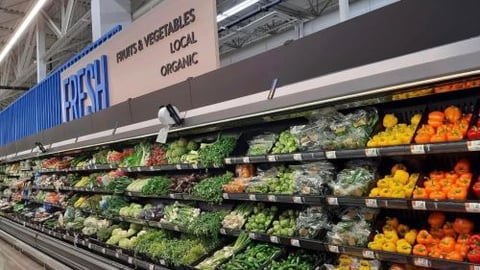How Amazon Became the Ultimate Grocery Competitor
Amazon is one of the largest grocers in the United States, with more than $100 billion in gross sales — not including sales from Whole Foods Market and Amazon Fresh. In a new blog post, Jason Buechel, VP of Amazon worldwide grocery stores and CEO of Whole Foods, explained how this e-comm giant built the large grocery business it has today.
"Over two decades ago, we started adding groceries and everyday household essentials to Amazon.com that don't require temperature control — items like bulk paper, cleaning products, large packs of canned and boxed food, and bottled drinks," wrote Buechel. "Customers in big cities and rural communities alike loved the convenience of buying these items online and having them delivered quickly. So, over time we’ve lowered our cost to serve to cost-effectively add smaller packs of the most purchased items, and broader selection of low-priced items. These are the items that make up the center aisles of grocery stores."
Further, since customers who are shopping for these kinds of products typically want them fast, Amazon has accelerated its delivery speeds over the past few years, increasingly offering same-day and one-day delivery on many items. To do this, the company regionalized its U.S. fulfilment network to store a wider selection of products close to customers and opened more same-day delivery sites, which enable Amazon to offer millions of items for delivery within hours in more than 140 metro areas nationwide.
Buechel pointed out that more than 2 billion groceries and household essentials were delivered the same or next day in the United States in 2024 — an increase of 50%-plus year over year. As a result, in the first three months of 2025, Amazon’s everyday essentials grew more than twice as fast as all other categories in the United States, and represented one out every three units sold.
Today, Amazon offers nearly 3 million affordable grocery and household essential items for delivery across the country.
[RELATED: Amazon Is the Lowest-Priced Online Retailer: Study]
In addition to the shelf-stable products and household goods available on Amazon.com, tens of millions of customers turn to Amazon Fresh and Whole Foods Market for their full-service grocery needs. What’s more, customers in more than 3,500 cities and towns can use the Amazon website or mobile app to shop groceries across Whole Foods, Amazon Fresh, and local grocery and specialty retailers for delivery and pickup. Prime members get unlimited grocery delivery on orders of more than $35 with a $9.99 monthly or $99.99 yearly grocery delivery subscription.
When it comes to physical stores, Whole Food Market has expanded to more than 535 locations nationwide and Amazon Fresh has more than 60 stores. According to Buechel, Amazon Fresh and Whole Foods together generated tens of billions in sales in 2024, but Amazon isn’t resting on these impressive numbers.
“We know if we want to serve as many customers as we want, we need to have a broader mass perishables offering,” said Amazon CEO Andy Jassy during a recent Q&A session with shareholders. “We've been working on the second version of our physical Amazon Fresh stores, and those are showing meaningful progress in terms of what the performance looks like versus the first version of those Fresh stores.”
Amazon has also been experimenting with a number of other concepts. For example, the retailer is using its same-day facilities to enable customers to easily shop fresh groceries alongside millions of other products. Amazon is already piloting this concept in Phoenix, Kansas City, and Orlando, Fla., with plans to expand the offering throughout 2025, allowing more customers same-day delivery of perishable along with nonperishable items.
Buechel also made mention in his blog post of other new experiences that Amazon is testing, among them:
- Co-locating selections from Whole Foods Market, Amazon.com and Amazon Fresh in the same fulfilment center, enabling customers to shop items from all three brands and have them delivered in a single order
- Opening a small-format grocery store under the same roof as Whole Foods Market in Chicago, letting customers shop their favorite natural and organic products at Whole Foods and getting a broader product assortment from Amazon in one trip
- Launching Whole Foods Market Daily Shop, a quick-shop store format that’s fast and convenient.
For more information on how Amazon is revolutionizing grocery, check out Progressive Grocer Editorial Director and Associate Publisher Gina Acosta’s retailer deep dive.
Seattle-based Amazon is No. 2 on The PG 100, Progressive Grocer’s 2025 list of the top food and consumables retailers in North America. The company was also named among PG’s Retailers of the Century and appeared on its Most Sustainable Grocers list.






